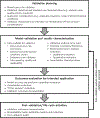Validation of Bioavailability-Based Toxicity Models for Metals
- PMID: 31880834
- PMCID: PMC8218924
- DOI: 10.1002/etc.4563
Validation of Bioavailability-Based Toxicity Models for Metals
Abstract
Regulatory jurisdictions worldwide are increasingly incorporating bioavailability-based toxicity models into development of protective values (PVALs) for freshwater and saltwater aquatic life (e.g., water quality criteria, standards, and/or guidelines) for metals. Use of such models for regulatory purposes should be contingent on their ability to meet performance criteria as specified through a model-validation process. Model validation generally involves an assessment of a model's appropriateness, relevance, and accuracy. We review existing guidance for validation of bioavailability-based toxicity models, recommend questions that should be addressed in model-validation studies, discuss model study type and design considerations, present several new ways to evaluate model performance in validation studies, and suggest a framework for use of model validation in PVAL development. We conclude that model validation should be rigorous but flexible enough to fit the user's purpose. Although a model can never be fully validated to a level of zero uncertainty, it can be sufficiently validated to fit a specific purpose. Therefore, support (or lack of support) for a model should be presented in such a way that users can choose their own level of acceptability. We recommend that models be validated using experimental designs and endpoints consistent with the data sets that were used to parameterize and calibrate the model and validated across a broad range of geographically and ecologically relevant water types. Environ Toxicol Chem 2019;39:101-117. © 2019 SETAC.
Keywords: Biotic ligand model; Metal bioavailability; Metal toxicity; Model performance; Validation; Water chemistry.
© 2019 SETAC.
Figures





References
-
- Arnold WR. 2005. Effects of dissolved organic carbon on copper toxicity: Implications for saltwater copper criteria. Integr Environ Assess Manag 1:34–39. - PubMed
-
- Australian and New Zealand Governments. 2019. Australian and New Zealand guidelines for fresh and marine water quality. Canberra, ACT, Australia. [cited 2019 November 11]. Available from: www.waterquality.gov.au/anz-guidelines
-
- Balistrieri LS, Mebane CA, Schmidt TS, Keller W. 2015. Expanding metal mixture toxicity models to natural stream and lake invertebrate communities. Environ Toxicol Chem 34:761–776. - PubMed
-
- Batley GE, Apte SC, Stauber JL. 2004. Speciation and bioavailability of trace metals in water: Progress since 1982. Aust J Chem 57:903–919.
Publication types
MeSH terms
Substances
Grants and funding
LinkOut - more resources
Full Text Sources

